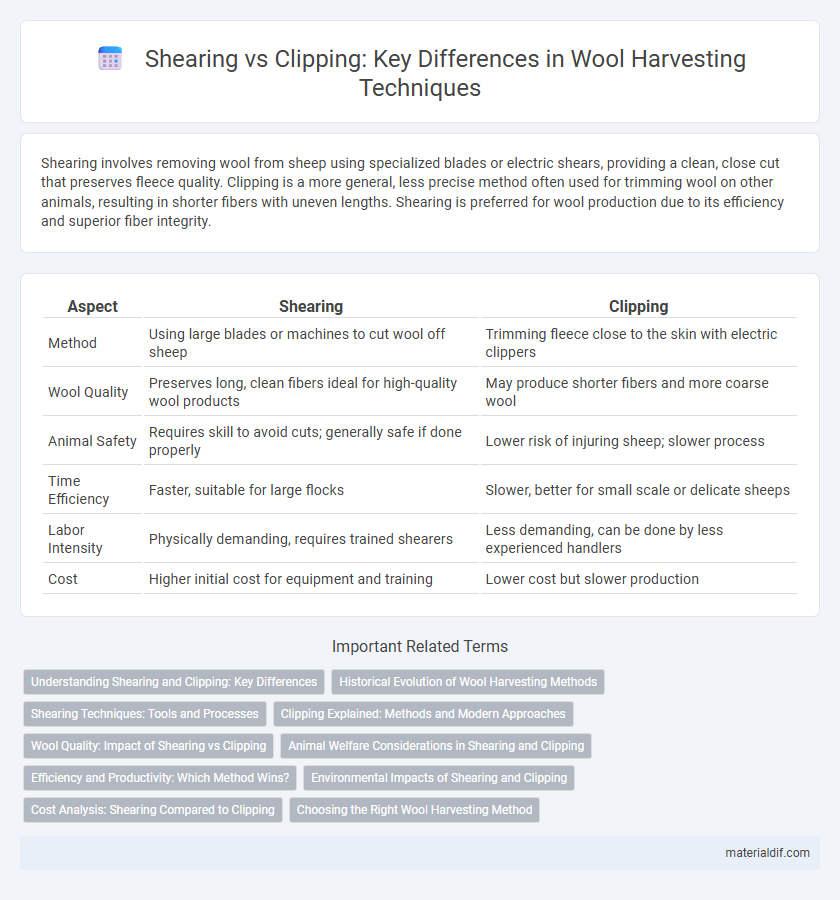Shearing involves removing wool from sheep using specialized blades or electric shears, providing a clean, close cut that preserves fleece quality. Clipping is a more general, less precise method often used for trimming wool on other animals, resulting in shorter fibers with uneven lengths. Shearing is preferred for wool production due to its efficiency and superior fiber integrity.
Table of Comparison
| Aspect | Shearing | Clipping |
|---|---|---|
| Method | Using large blades or machines to cut wool off sheep | Trimming fleece close to the skin with electric clippers |
| Wool Quality | Preserves long, clean fibers ideal for high-quality wool products | May produce shorter fibers and more coarse wool |
| Animal Safety | Requires skill to avoid cuts; generally safe if done properly | Lower risk of injuring sheep; slower process |
| Time Efficiency | Faster, suitable for large flocks | Slower, better for small scale or delicate sheeps |
| Labor Intensity | Physically demanding, requires trained shearers | Less demanding, can be done by less experienced handlers |
| Cost | Higher initial cost for equipment and training | Lower cost but slower production |
Understanding Shearing and Clipping: Key Differences
Shearing involves the precise removal of wool or fleece from sheep using specialized hand or electric shears, targeting the fleece near the skin to maximize wool quality and yield. Clipping focuses on trimming wool or hair on sheep without necessarily removing the entire fleece, often used for maintenance or aesthetic purposes rather than wool production. Understanding these key differences impacts wool harvesting efficiency, fiber length, and the overall health of the sheep.
Historical Evolution of Wool Harvesting Methods
Shearing, originating over 10,000 years ago during the Neolithic era, has been the primary method for harvesting wool, involving the careful removal of fleece with specialized blades to preserve fiber quality. Clipping developed as a mechanical alternative in the 19th century, using powered devices to increase efficiency but often resulting in coarser fibers and uneven cuts compared to traditional shearing. The historical evolution from manual shearing to mechanized clipping reflects advancements in technology aimed at meeting industrial wool demands while balancing fiber integrity and harvesting speed.
Shearing Techniques: Tools and Processes
Shearing techniques for wool primarily involve using electric or manual shears designed to efficiently remove fleece without damaging the sheep's skin. Modern shearing tools include specialized shearing machines with adjustable combs and cutters, enabling precise cuts tailored to different wool types. Proper shearing processes emphasize maintaining animal welfare, ensuring clean, even removal of fleece to optimize wool quality and reduce post-shearing defects.
Clipping Explained: Methods and Modern Approaches
Clipping wool involves using electric clippers or hand shears to remove fleece close to the skin, minimizing fiber damage and enabling faster harvesting compared to traditional shearing. Modern approaches incorporate ergonomic tools with adjustable blades and motor speeds to enhance precision and reduce stress on sheep. Advanced clipping techniques also integrate automated systems and sensor technology for consistent fiber quality and improved animal welfare during the process.
Wool Quality: Impact of Shearing vs Clipping
Shearing preserves wool fiber length and strength, resulting in higher-quality fleece with better insulation properties and durability. Clipping can cause uneven cuts and fiber damage, reducing wool's uniformity and market value. Optimal wool quality depends significantly on shearing techniques that minimize fiber breakage and contamination.
Animal Welfare Considerations in Shearing and Clipping
Shearing and clipping sheep have distinct impacts on animal welfare, with shearing often preferred for its efficiency in removing fleece while minimizing stress and injury risk. Proper shearing techniques promote healthier skin and reduce parasite infestations, whereas improper clipping can cause skin nicks or insufficient wool removal, leading to discomfort and overheating. Regular monitoring and skilled handling during both processes are essential to ensure the animals' well-being and prevent distress.
Efficiency and Productivity: Which Method Wins?
Shearing offers greater efficiency in wool harvesting by enabling faster removal of fleece with minimal stress on the sheep, resulting in higher productivity. Clipping, while more precise and yielding cleaner wool samples, is typically slower and less suited for large-scale wool production. For maximizing output and operational efficiency, shearing remains the preferred method among wool producers.
Environmental Impacts of Shearing and Clipping
Shearing wool reduces environmental impact by promoting sheep health and allowing natural coat regrowth, which supports sustainable fleece production and soil nutrient cycling. Clipping, often involving mechanical or chemical means, can stress animals and potentially lead to higher energy consumption and waste from non-renewable materials. Choosing shearing over clipping aligns with eco-friendly practices by minimizing carbon emissions and preserving animal welfare in wool harvesting.
Cost Analysis: Shearing Compared to Clipping
Shearing typically incurs higher upfront labor and equipment costs compared to clipping, but offers superior wool quality that can command better market prices. Clipping reduces time and labor expenses, making it a cost-effective option for operations focused on rapid processing rather than premium wool output. Evaluating long-term profitability requires balancing shearing's investment in skilled labor against clipping's savings and potential reductions in fleece value.
Choosing the Right Wool Harvesting Method
Shearing is the traditional method of wool harvesting that involves removing the fleece in one piece, preserving fiber length and quality ideal for high-grade wool production. Clipping, on the other hand, targets shorter fleece sections and is often used for purposes requiring coarser wool or less uniform fiber. Selecting the right method depends on breed, wool end-use, and animal welfare considerations to maximize fiber yield and maintain fleece integrity.
Shearing vs Clipping Infographic

 materialdif.com
materialdif.com